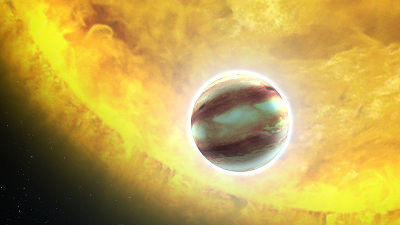Methane and sulfur dioxide were discovered in the atmosphere of the planet K2-18 B, which is in the habitable zone for life, indicating the existence of an ocean, and dimethyl sulfide, which only exists on Earth from biological sources, was also detected.

The presence of water vapor was
Webb Discovers Methane, Carbon Dioxide in Atmosphere of K2-18 b | NASA
https://www.nasa.gov/goddard/2023/webb-discovers-methane-carbon-dioxide-in-atmosphere-of-k2-18b

Webb discovers methane, carbon dioxide in atmosphere of K2-18 b | ESA/Webb
https://esawebb.org/news/weic2321/
Methane and carbon dioxide found in atmosphere of habitable-zone exoplanet
https://www.cam.ac.uk/stories/carbon-found-in-habitable-zone-exoplanet?ucam-ref=home-hero
The existence of water is extremely important for living things to survive. Whether or not water can exist on a planet depends on its distance from the star and its atmospheric pressure, and the region where water can exist if there is appropriate atmospheric pressure is called the habitable zone. For example, the habitable zone of the solar system is defined as the range between 0.97au and 1.39au from the sun (the distance between the sun and the Earth is 1au).
Planets within the habitable zone are more likely to have life than other planets, so researchers searching for extraterrestrial life focus their analysis on planets within the habitable zone. . 'K2-18 b' is a planet that exists in the habitable zone of the star 'K2-18' located 120 light years away from Earth, and in 2019, an analysis of data recorded by the Hubble Space Telescope revealed that water vapor existence was confirmed.
The presence of water is confirmed for the first time on a giant terrestrial planet outside the solar system - GIGAZINE

A new analysis of K2-18 b's atmospheric composition using a spectrometer on the James Webb Space Telescope revealed that K2-18 b's atmosphere is rich in methane and carbon dioxide, and contains ammonia. It has become clear that there are only a few. According to the research team, the atmospheric composition of ``rich in methane and carbon dioxide and low in ammonia'' suggests that there is an ocean in ``K2-18 b''. The research team also states that this is the first time that carbon-containing molecules have been detected on a planet that exists in the habitable zone outside the solar system.

Furthermore, it was suggested that dimethyl sulfide (DMS) may exist in the atmosphere of 'K2-18 b.' Dimethyl sulfide exists only from biological sources on earth. The research team said, ``The results of this study demonstrate the importance of assuming a variety of habitat environments in the search for extraterrestrial life forms.Generally, the search for extraterrestrial life forms is conducted on small rocky planets (Earth 'However, large planets (like K2-18 b) are suitable for analyzing atmospheric composition.'
According to the research team, the data used for this analysis was obtained from two observations with the James Webb Space Telescope. The James Webb Space Telescope is said to be able to obtain data equivalent to eight observations by the Hubble Space Telescope for each observation, and expectations are high for future research acceleration.
Related Posts:
in Science, Posted by log1o_hf






